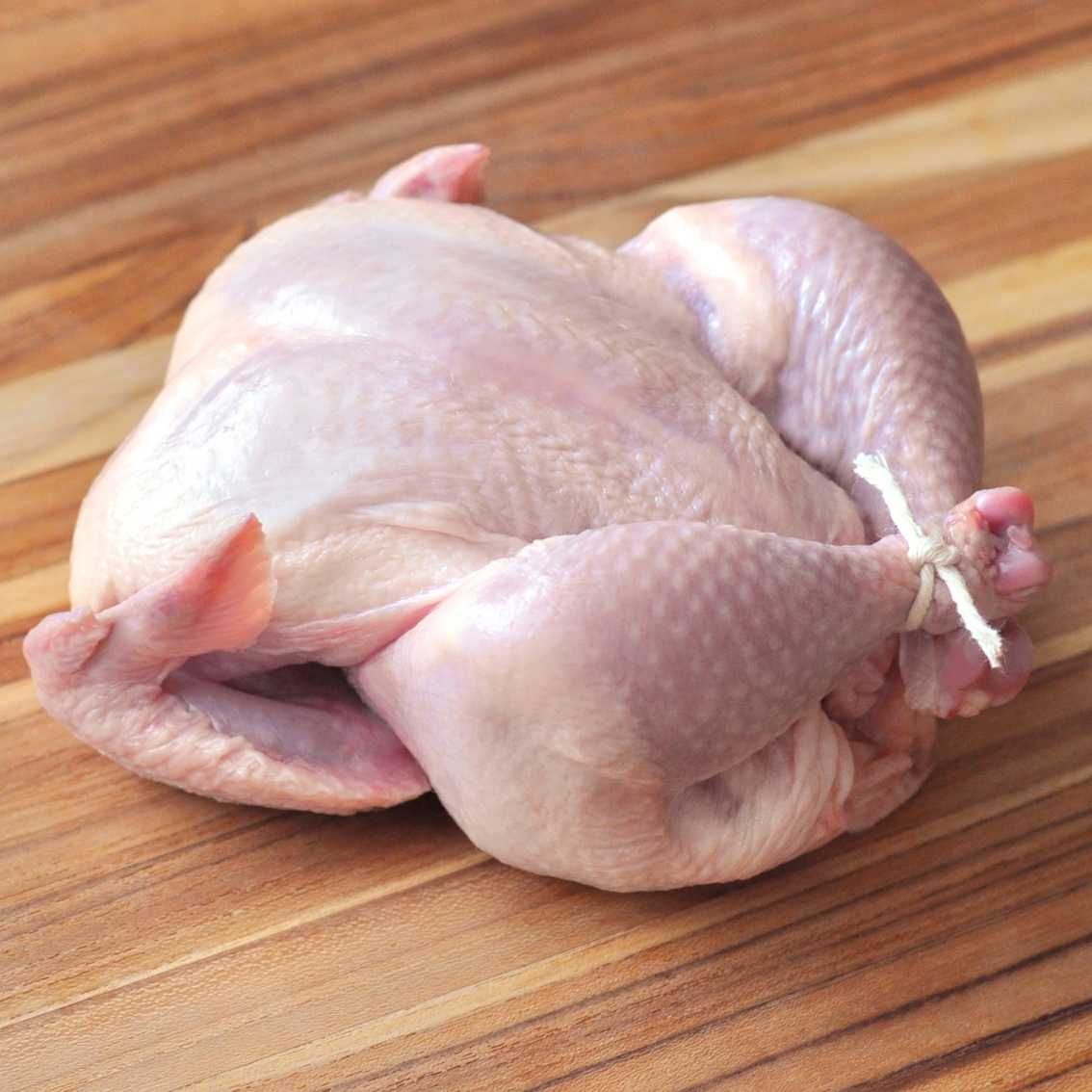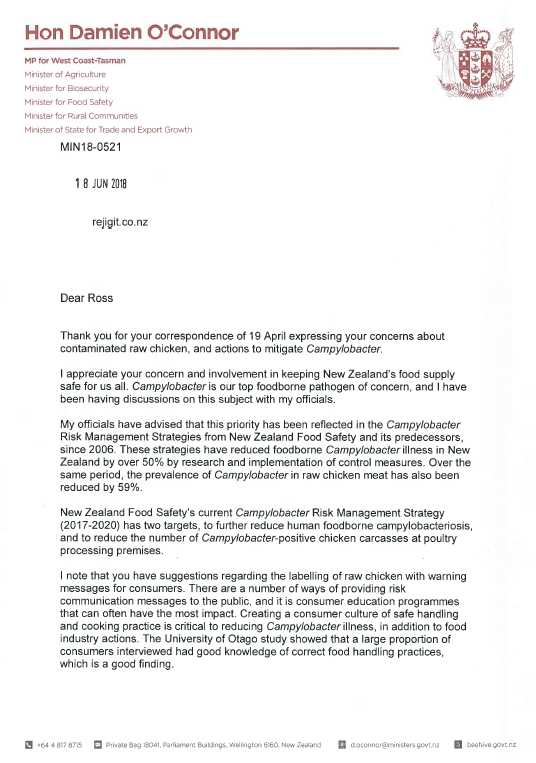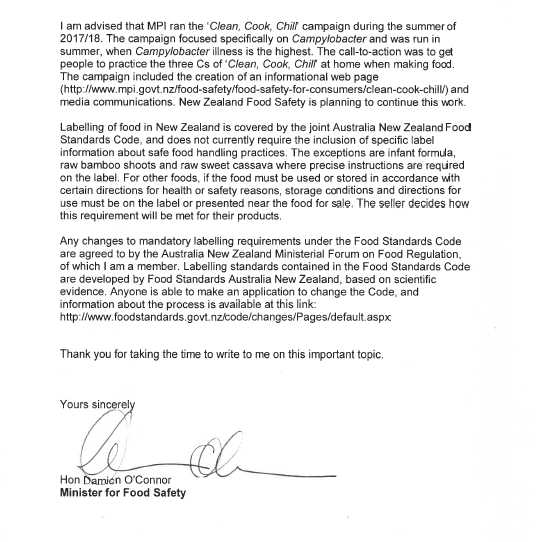
Update 26 September 2022
Radio New Zealand published an in-depth article dated 25 September 2022 by Farah Hancock entitled "Why NZ remains a campylobacter capital", in which she interviewed a number of New Zealand epidemiologists. Maybe now that epidemiologists are not so preoccupied with things Covid-19 related, they could focus on what for New Zealand is a national disgrace. It is equally disgraceful that New Zealand's Ministry of Primary Industries which is charged with the responsibility for such matters, appears to be asleep at the wheel.
The upshot is that since Rejigit initially wrote about the Camylopbacter problem in July 2017, no perceptible improvement has taken place, in fact the situation may have deteriorated.
In the meantime, a prudent piece of advice is, always freeze chicken before cooking it! Ordinarily "fresh is best" is an appropriate mantra however in the case of New Zealand processed chicken that is not appropriate.
https://www.rnz.co.nz/news/in-depth/475396/why-nz-remains-a-campylobacter-capital
.
Update 21 June 2018
Rejigit referred previous blog posts (10 July 2017 & 18 April 2018) to Hon Damien O'Connor in his capacity as Minister for Food Safety and his response is below.


Update 18 April 2018
Rejigit previously wrote about what is described as New Zealand’s No.1 Food Safety problem on 10 July 2017.
The previous National Government’s minister for food safety, Hon David Bennett, sat on his hands over this extremely serious matter and it is high time the current minister, Hon Damien O’Connor stepped up with a legal requirement for prominent safety warnings and cooking recommendations on all fresh poultry product. A University of Otago, Wellington study, published last week in the international journal BMC Public Health describes how New Zealand has one of the highest rates of campylobacteriosis in the world and at least half of those cases can be attributed to contaminated chicken. The study also describes how only approximately 15% of consumers were aware that up to 90% of fresh chicken meat sold in New Zealand may be contaminated with Campylobacter.
Campylobacter causes campylobacteriosis, a severe form of gastroenteritis which affects thirty thousand people in New Zealand each year, hospitalises approximately six hundred people each year and paralyses an estimated thirty people with Guillain-Barre syndrome.
Something needs to be done immediately. Many New Zealanders (thirty thousand of them!) are going down like sprayed flies.

TV1 News last evening included a report about this matter and also included comment from Michael Brooks, C.E.O. for Poultry Industry Association New Zealand. It beats Rejigit how this individual is given any air time over this issue. It was a blatant example of an industry spinning a response entirely in their own interests while suggesting it wasn’t a significant problem at all. It was a bloody outrageous attitude.
Original article 10 July, 2017
Kim Hill is a New Zealand radio icon and a treasure. During her Radio New Zealand National program (101.0 FM – 101.7 FM depending on where you are) last Saturday morning (08 July) she interviewed Dr Arie Havelaar.
The interview can be found here http://www.radionz.co.nz/national/programmes/saturday

Dr Havelaar is a professor in the Department of Animal Sciences at the University of Florida, specialising in microbial risk assessment and epidemiology of food-borne diseases. He is also affiliated with the Institute for Sustainable Food Systems and the Emerging Pathogens Institute.
In the course of his discussion with Kim Hill, he indicated that up to 50% of live poultry in New Zealand may be infected with Campylobacter. The disease colonises the gut of poultry and other animals but has no affect on them as the carrier but can be transferred to the outside of chickens and chicken products in the course of being processed for sale. It is critical therefore to properly cook chicken and to avoid the potential for cross-contamination with other foods while in its raw state (it is not recommended to wash chicken prior to cooking because splashing can cause cross-contamination). Consuming rare cooked chicken livers is potentially dangerous. He also mentioned that consuming unpasteurised (raw) milk is not recommended because it carries a high risk of containing Campylobacter and E.coli etc. International research has confirmed that freezing chicken for a minimum of four days effectively eliminates Campylobacter risk.
Infection by Campylobacteriosis can bring about severe diarrhoea and in terms of one in a thousand cases, can afflict the patient with any of a number of autoimmune diseases (such as Giambruno Syndrome, a potentially life-long paralytic disease similar to Poliomyelitis and which can bring about an inability to breathe and require artificial ventilation). Chronic long-term arthritis is another potential risk associated with Campylobacteriosis.
Studies in Denmark have confirmed that if poultry rearing houses are well designed and include effective fly screens, the Campylobacter risk profile can be reduced to below 10 – 15%. Alternatively if poultry are reared in an open environment, every bird (100%) will be colonised by Campylobacter as a consequence of fly-borne contamination.
Dr Havelaar has a particular interest in the increasing production of poultry protein in developing countries and how that impacts on children through their exposure to chicken shit. Even if children do not suffer acute diarrhoea, Campylobacter bacteria can asymmetrically colonise the intestines of children causing permanent damage to their gut and resulting in an inability to absorb nutrients together with chronic inflammation leading ultimately to malnutrition and growth stunting.
Rejigit is relying on an assumption of Campylobacter Acquired Immunity which apparently comes about as a result of low level exposure over a prolonged period. We recognise Dr Havelaar’s expertise in these matters but some of what he says prompts the old idiom “Dammed if you do, damned if you don’t”. We fully support the campaign to restrict poultry rearing conditions to only under humane conditions and free of all cruelty! Here’s the conundrum; Hens in well designed houses with fly screens = less than 10 – 15% Campylobacter contamination. Free Range Hens = 100% Campylobacter contamination. Chicken frozen for more than four days = zero Campylobacter. Fresh Free Range chicken = ?